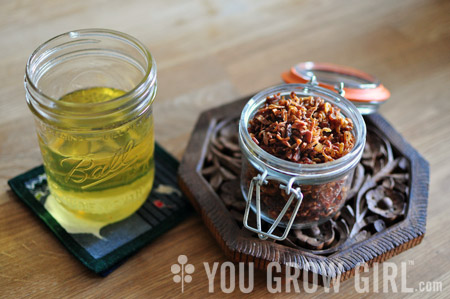
Recently, the addition of an island/counter that has suddenly provided me with more counter space than I have ever had before, as well as the well-timed arrival of an indulgent purchase of newly published cookbooks has us spending whole days in the kitchen. I am always drawn to the kitchen in other people’s homes. It’s the room I always seem to migrate to and camp out in for the duration during a party. I can’t express how happy I am now to have a counter that offers me the chance to spread out a little while I cook and can, as well as the space to perch and socialize when Davin is doing the work.
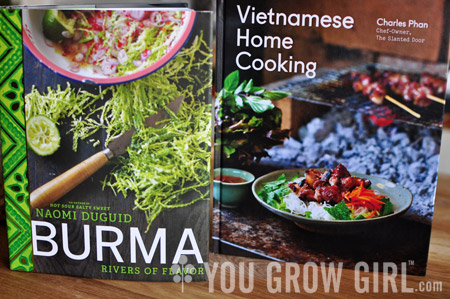
Now, on those books. I’m slowly making my way through the pile, savouring each one. I began first with two that feature South East Asian home cooking: Burma: Rivers of Flavor by Naomi Duguid and Vietnamese Home Cooking by Charles Phan. The first, “Burma,” is my favourite sort of cookbook, with as much put into telling personal stories and offering a small window into a culture through beautiful images as it is a manual for cooking good food. “Vietnamese Home Cooking” is not a travel journal, but it does have a personable element to it that includes beautiful photographs taken by photographer Eric Wolfinger. I have already used the advice in this book to successfully purchase my first set of cleavers and tightly wrap a proper spring roll.
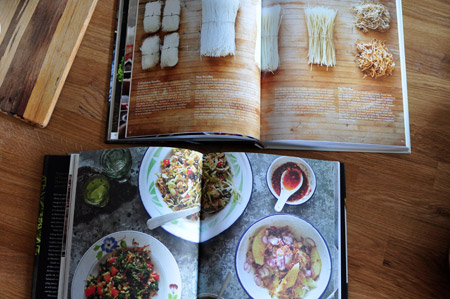
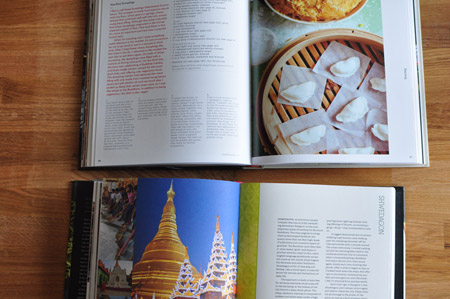
While initially browsing through “Burma” I noticed mention of Asian shallots and a recipe for making shallot oil. The recipe involves thinly slicing the shallots and frying them to a crisp in a flavourless oil such as peanut or canola. Through this process, you end up with two distinct ingredients for the pantry: crispy shallots that can be sprinkled as a garnish on soups and salads, and a flavourful oil that can be cooked with or used fresh in salad dressing. I became intrigued by this idea since I could see many applications for both ingredients beyond Asian cuisine. Soon after, while flipping through “Vietnamese Home Cooking” shallot oil came up again, this time used as the oil base for a savoury homemade mayonnaise that is then spread onto spring rolls. I had to make it.
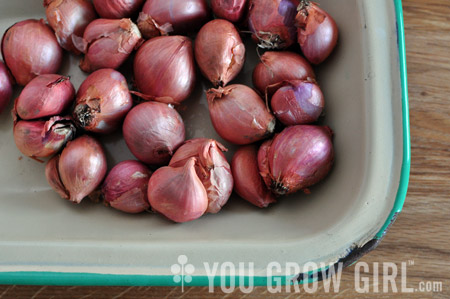
RECIPE: Crispy Fried Shallots and Shallot Oil
This is not so much a recipe as it is a testing of methods. So far all methods work so there is really no right or wrong way to do this as long as you are careful not to burn the shallots. Timing is everything. I’ve found that they can go from a nice golden brown to too dark in a blink of an eye.
-
Ingredients:
- Asian shallots
- Canola or peanut oil
First, I went to Chinatown in search of Asian shallots. They are smaller than the French shallots I typically cook with, and less wet. They are not, however, less tear-inducing. I cried like a baby while chopping them up. I have tried researching a source so that I can grow this type next year, but I haven’t had any luck finding a source or a variety name for that matter. Searches for “Asian shallot” have come up blank. If you have any insight into this please let us know in the comments.
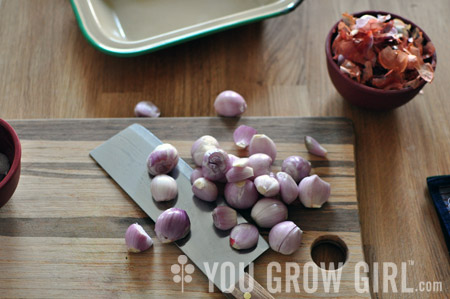
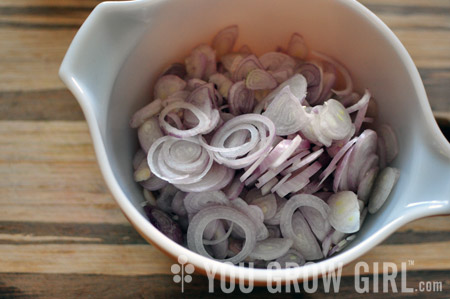
Peel the shallots and slice them thinly.
At home, I made a small batch first, following the directions in “Burma,” but cutting the amount of shallots in half and increasing the quantity of oil. I found that the trick is to cook them very slowly on a minimum heat. I overcooked the first batch slightly because I was impatient and did not turn the burner down low enough. Fortunately, both the oil and the crispy shallots were still good. I then used the oil to make the shallot mayonnaise from “Vietnamese Home Cooking.” Chef Phan’s recipe does not call for an acid as is the case with most mayonnaise. I did not like the heaviness of the shallot mayonnaise on its own and ended up adding a little white wine vinegar at the end, which brightened it up considerably. It was delicious on spring rolls and we soon found so many other uses for it (sandwiches, sweet potato fries… just about everything) that we are already working our way through a second batch.
The second time I tried making shallot oil I went through the labour of thinly slicing 2 cups and then fried them in 1 1/2 cups of canola oil on the very lowest heat setting on my stove. I watched the shallots for what seemed like ages, scooped them out with a slotted spoon, and dried them off on a blanket of paper towels. Again impatience got the best of me and they were not crispy enough, so I turned to the instruction in “Vietnamese Home Cooking,” which recommends cooking them once, drying them off, and then refrying quickly in much hotter oil as you would when making chips the English way. This method worked out well, but is extra work. Next time I will stick with the ease of a smaller batch by cooking 1 cup of thinly sliced shallots in approximately 1-1 1/2 cups of oil and try to get it right frying only one time on a low heat just a touch hotter than the very lowest setting.
As mentioned, we love both the oil and the crispy shallot bits. We are yet to find a meal that doesn’t benefit from the little bits and I am seriously considering trying them out as an ice cream topping next!
I’ve been intrigued by the shallot oil since getting a copy of “Burma” (beautiful book, right?!). Thinking of adding more shallots to my garden just for these recipes.
Yes, it is very beautiful. I love the photo of the cave of buddhas. One of my favourite things about Thailand were the reclining buddhas.
Can’t you just grow the shallots from Chinatown? I’m sure they will grow in Toronto!
As for preventing the tears while chopping some nasty members of onion family, my Mom taught me a trick. You have to take a sip of water, but don’t swallow it, just keep it in your mouth during cutting. It really works!
I can try, but would rather find an organic source for the shallots.
Thanks for the tip. I hadn’t heard of that one!
Nom. I’m going to have to try that, if I can find the shallots in this tiny city. As for chopping members of the onion family, my mom just showed me a tip – apparently most of the chemical that makes us cry is in the tough core that I always end up picking out anyways. She chopped an onion leaving it intact while we were making salsa, and neither of us cried. Usually, both of us end up in a different rooms, trying to recover from chopping one onion.
That’s how I dice an onion (leaving the core intact to hold it all). I’ve never noticed a difference but will pay closer attention.
Wear swimming goggle while chopping onion (a tip from my swimming instructor).
Forgive me, I’m going to nerd out for a second…
There is a great tip for cutting onions in the book Cooking for Geeks! Apparently, there is a compound in onions that, once combined with water, results in sulfuric acid. Since the closest source of water to the onion is usually your eyeballs, that’s the water it binds with and…voila, sulfuric acid in your eye (hence the burning and tearing-up). The book says the simplest way to prevent that from happening is to have a water source closer to the onion…wet the cutting board and knife before slicing and the compound will bind with that water before it has a chance to find your eyes!
The actual text from the book is here, and you can listen to the author explain it all as he did on NPR’s Science Friday: http://www.cookingforgeeks.com/blog/posts/npr-science-friday/
Interesting. I will try it.
Hi…I just ordered the Burma cook book and I can’t wait for it to get here!!! “Merry Christmas to Karen” I like seeing what you are reading. I’m a huge fan of books and you always seem to be reading great ones!!
PS. My 3 favorite books are by Gayla trail.
Thanks so much Karen! You’ll love the book.
After reading this I had to run straight out and buy the book. I also made the chili oil as I had an abundance of hot chilis this year. It was wonderful.